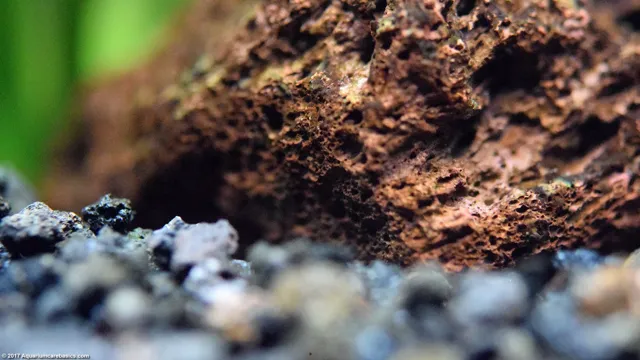Adding natural elements to an aquarium can help recreate a realistic habitat for fish and create a beautiful underwater environment. Manzanita wood can be an excellent addition to any aquarium, providing natural hiding places for fish and adding to the aesthetic appeal of the tank. However, it is essential to properly prepare the wood to ensure it does not harm your fish or affect the quality of the tank’s water.
In this blog post, we will explore the steps required to prepare Manzanita wood for an aquarium, ensuring it is safe for your fish and adding to the overall health of your tank. So, if you are looking to add Manzanita wood to your aquarium, keep reading to learn how to get started.
What is Manzanita?
Manzanita is a type of wood that has become increasingly popular in the aquarium hobby. It is known for its unique appearance and durability in water. If you’re looking to use manzanita in your aquarium, it’s important to prepare it properly.
First, it’s essential to source your manzanita from a reputable supplier and make sure it’s been cleaned of any dirt or debris. Once you have your manzanita, it’s recommended to soak it in a container of water for several days or even weeks to help remove tannins that may affect the color and pH levels of your aquarium’s water. You can also boil the manzanita to further remove tannins and sterilize the wood.
After boiling, it’s best to let the manzanita dry out completely before placing it in your aquarium. With proper preparation, manzanita can make a beautiful and natural addition to your aquarium décor.
Origin and Characteristics
Manzanita is a beautiful shrub or small tree found in Western North America. It is known for its striking bark, which peels off in thin curls, revealing smooth, reddish-brown wood underneath. Manzanita leaves are small, leathery, and evergreen, with a shiny surface that helps them retain water in arid environments.
The word “manzanita” comes from the Spanish word for “little apple,” referring to the small, red or yellow berries that the plant produces. These berries are a favorite food source for local wildlife, including birds, bears, and deer. Manzanita is also valued for its durability and beauty, and it has been used for centuries by indigenous peoples for various purposes, from tool-making to basketry.
Today, manzanita is a popular landscaping plant and is often grown for its ornamental value, particularly in dry gardens and xeriscapes.

Benefits for Aquariums
Manzanita is a type of hardwood tree that can be found in North America. Its unique branching structure and beautiful red-brown color make it a popular choice for aquarium enthusiasts. Not only does it add a natural touch to aquariums, but it also provides many benefits.
Manzanita is a hardwood which means it won’t rot when submerged in water, and it won’t release any harmful chemicals or tannins that can harm aquatic life. It’s also a great hiding place for fish, which reduces their stress levels and promotes healthy behavior. Manzanita wood has natural grooves and crevices that create a perfect environment for beneficial bacteria that help break down waste and keep the water clean.
Another great thing about Manzanita is that it doesn’t need to be boiled or treated before being added to your aquarium. Simply wash it thoroughly and add it to your tank, and it will provide natural beauty and benefits for years to come.
Cleaning Manzanita
If you’ve ever worked with manzanita wood before, you know that it can be a bit of a challenge to get it clean and ready for your aquarium. Luckily, with a little bit of elbow grease and patience, the process isn’t too difficult! The first step is to soak your manzanita in a container of water for at least 24 hours. This will help to loosen any dirt or debris that is on the wood.
Once it has soaked, you can use a soft-bristled brush to gently scrub away any remaining dirt or loose bark. Be sure to rinse the wood thoroughly with clean water afterward. The next step is to sterilize your manzanita to prevent any unwanted bacteria or parasites from getting into your aquarium.
To do this, you can boil the wood in a large pot of water or bake it in the oven at a low temperature. If you choose to boil it, make sure to keep the wood submerged for at least 30 minutes. If you choose to bake it, preheat your oven to 250 degrees Fahrenheit and bake the wood for at least an hour. (See Also: How to Change Your Aquarium from Gravel to Sand: A Step-by-Step Guide)
Once your manzanita has cooled, it’s ready to be added to your aquarium! It’s important to remember that manzanita wood can release tannins into the water, which can turn the water brown. This is normal and will go away with time. If you don’t want to wait for the tannins to dissipate naturally, you can use activated carbon or water changes to speed up the process.
Overall, with a little bit of care and attention, you can enjoy the beauty and benefits of manzanita wood in your aquarium.
Soaking and Scrubbing Methods
When it comes to cleaning Manzanita, there are two popular methods – soaking and scrubbing. Soaking involves submerging the Manzanita in water for an extended period, which allows for the buildup of algae and debris to become loose and easily removed. Scrubbing, on the other hand, involves using a brush or sponge to manually scrub the Manzanita clean.
Both methods can be effective, but it ultimately depends on the level of cleaning that is needed. For a deeper clean that removes all traces of buildup, scrubbing may be the better option. However, if the Manzanita is only mildly dirty, soaking can be a great way to remove surface-level debris quickly.
It’s important to note that while soaking can be convenient, it’s vital to thoroughly rinse and dry the Manzanita afterward to prevent mold growth. Regardless of the cleaning method used, regular maintenance is essential to keep Manzanita looking its best and to maintain the health of any aquatic inhabitants it houses.
Removing Excess Tannins
Manzanita branches are a popular choice for aquascaping and terrarium decor due to their unique shape and reddish-brown color. However, these branches are known to leach excess tannins into the water, leading to yellowish water and potentially harmful effects on aquatic life. To clean manzanita branches and remove excess tannins, there are several methods one can use.
Boiling the branches in water for several hours can remove the tannins, but this can also cause the branches to lose their color and shape. Soaking the branches in water for several weeks is another method, but this can be a slow process and may not effectively remove all the excess tannins. A quicker and more efficient method is to use activated carbon in a filter or as a direct media to absorb the tannins.
This can be added to the tank or filter and changed out regularly until the excess tannins are fully removed. By taking these steps, you can ensure that your manzanita branches are clean and safe for your aquatic pets to enjoy.
Boiling Manzanita
If you’re looking to add an interesting element to your aquarium, consider using manzanita wood. Manzanita is a beautiful driftwood that makes an excellent addition to any aquarium. However, before adding it to your tank, it’s essential to prepare it properly.
The best way to do this is by boiling it. Boiling manzanita wood helps to remove any tannins and other impurities that can harm your fish. To boil manzanita, simply fill a large pot with enough water to fully submerge the wood and bring it to a boil.
Once the water is boiling, add the manzanita and let it boil for at least an hour. After an hour, remove it from the pot and allow it to cool completely before adding it to your aquarium. Boiling manzanita is a straightforward process that will help ensure the health and happiness of your aquatic pets.
So, if you’re looking to add a unique and natural touch to your aquarium, give manzanita wood a try!
Process and Duration
If you’re looking to extract tannins from manzanita, boiling is the best way to go about it. This process not only extracts the tannins but also removes any impurities that might be present in the bark. To begin, chop the manzanita bark into small pieces and place it in a pot with water. (See Also: How to Make Aquarium Silent for Happy and Healthy Fish: Tips and Tricks)
Bring the mixture to a boil and let it simmer for several hours until the water turns a reddish-brown color. This indicates that the tannins have been extracted from the bark. You can then strain the liquid through cheesecloth and use it for various applications such as tanning leather or dyeing fabrics.
The duration of the process will depend on the quantity of bark you’re using and the desired strength of the tannin solution. It’s important to note that boiling manzanita bark produces a strong aroma, so be sure to have good ventilation. With patience and diligence, you can achieve a high-quality tannin solution that can be used for a wide range of purposes.
Benefits and Precautions
Boiling Manzanita is a traditional way of extracting the medicinal properties of the plant and has been used by indigenous people for centuries. Boiling Manzanita bark or leaves can aid in treating respiratory infections, inflammation, and diarrhea. It can also be used as a disinfectant for small wounds.
However, it’s essential to note that while boiling Manzanita is beneficial, caution should be taken because over boiling can cause the release of toxic hydrocyanic acid. Consuming large quantities of hydrocyanic acid can be dangerous and even fatal. It’s also essential to avoid boiling Manzanita in aluminum or iron pots because these metals can react with the tannins in the Manzanita and cause discoloration and a metallic taste.
The best option is to boil Manzanita in stainless steel or glass pots for maximum benefits. Overall, boiling Manzanita can be a potent natural remedy, but it’s crucial to understand the potential dangers and take precautions to avoid any adverse effects.
Final Preparations
Preparing manzanita wood for your aquarium can be a tedious yet rewarding process. Before introducing it into your tank, you must ensure that the manzanita has been thoroughly cleaned and properly prepared. To begin, soak the wood in a bucket of water for at least 24 hours, changing the water every few hours.
This process will help remove any excess tannins from the wood, preventing it from discoloring your tank water. Once the soaking is complete, you can scrub the manzanita with a clean brush to remove any remaining debris and ensure there are no rough or sharp edges. If you want to enhance the natural color and texture of the wood, you can also sand it down and varnish it.
Once everything is complete, rinse the manzanita one final time and it’s ready to be added to your aquarium. With these steps, your manzanita wood will not only be aesthetically pleasing but also safe for all your aquatic pets to enjoy.
Rinsing and Drying
Once you’ve finished washing your dishes, it’s important to give them a thorough rinse and dry before putting them away. This final step helps to ensure that no soap residue or water spots are left behind, leaving your dishes clean and ready for their next use. Start by rinsing each dish under running water, making sure to remove any remaining food particles or soap suds.
As you rinse, give each dish a quick visual inspection to make sure there are no lingering spots or stains. Once each dish is rinsed, set them out on a dish rack to air dry. If you’re short on time, you can use a clean dish towel to dry each dish by hand.
Just be sure to use a towel that’s free from any dirt or dust, as any debris can leave its own marks on your freshly cleaned dishes. With these final preparations, your dishes will be perfectly clean and ready to use again in no time.
Placement in Aquarium
When it comes to placing your aquarium in your home, there are a few final preparations to consider before setting it up. First and foremost, make sure the location you choose is suitable for the size and weight of your aquarium. You don’t want it to be too heavy for the surface it’s sitting on or too cramped in a small space.
Additionally, ensure that the area is not in direct sunlight or near any heating or cooling vents; fluctuations in temperature can be harmful to your fish. It’s also important to have access to a nearby power source and have all necessary equipment on hand, such as a water conditioner and a quality filtration system. Taking the time to carefully plan out the placement of your aquarium will help ensure a successful and healthy environment for your fish. (See Also: How to Get Rid of Black Beard Algae in Aquarium: Tips and Tricks)
So, take your time, think it through, and enjoy the process of setting up your new aquatic world in your home.
Conclusion
In conclusion, preparing manzanita for your aquarium requires patience and attention to detail, but the benefits are well worth the effort. Not only does it create a stunning natural look, but it also provides a healthy environment for your aquatic friends. Just remember to soak the wood to prevent unwanted tannins, and don’t be afraid to get creative with the placement and positioning of the driftwood.
With these tips in mind, your aquarium will be the envy of all fish enthusiasts and a Zen-like oasis for your underwater buddies.”
FAQs
What is Manzanita and why is it used in aquariums?
Manzanita is a type of wood that is commonly used in aquariums because it is non-toxic and does not release any harmful substances into the water. It also creates a natural-looking habitat for fish.
How do you choose the right Manzanita for your aquarium?
It is important to choose Manzanita that is free of any harmful chemicals, such as paint or sealant. Look for branches that have interesting shapes and textures, and avoid those with sharp edges that could harm your fish.
How do you prepare Manzanita for use in an aquarium?
Manzanita should be soaked in water for at least 48 hours to remove any debris or tannins that could discolor the water. After soaking, it should be scrubbed with a brush to remove any remaining debris.
Can Manzanita be used as a hiding place for fish in an aquarium?
Yes, Manzanita can be used as a hiding place for fish. Its natural shapes and crevices provide a great place for fish to explore and hide.
How long does Manzanita last in an aquarium?
Manzanita can last for several years in an aquarium as long as it is properly maintained and kept free of any harmful substances.
Can Manzanita be used in saltwater aquariums?
Yes, Manzanita can be used in saltwater aquariums. It is important to choose Manzanita that is free of any salt-sensitive wood species, such as cedar or pine.
How do you anchor Manzanita in an aquarium?
Manzanita can be anchored using aquarium-safe rocks or sand. It is important to make sure that the Manzanita is secure and does not shift in the water, which could harm the fish or disrupt the filtration system.







